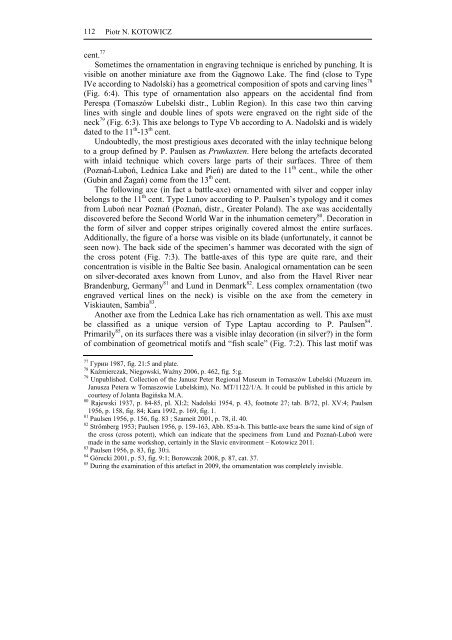Download - Facultatea de Științe Socio-Umane - Universitatea ...
Download - Facultatea de Științe Socio-Umane - Universitatea ...
Download - Facultatea de Științe Socio-Umane - Universitatea ...
Create successful ePaper yourself
Turn your PDF publications into a flip-book with our unique Google optimized e-Paper software.
112<br />
Piotr N. KOTOWICZ<br />
cent. 77<br />
Sometimes the ornamentation in engraving technique is enriched by punching. It is<br />
visible on another miniature axe from the Gągnowo Lake. The find (close to Type<br />
IVe according to Nadolski) has a geometrical composition of spots and carving lines 78<br />
(Fig. 6:4). This type of ornamentation also appears on the acci<strong>de</strong>ntal find from<br />
Perespa (Tomaszów Lubelski distr., Lublin Region). In this case two thin carving<br />
lines with single and double lines of spots were engraved on the right si<strong>de</strong> of the<br />
neck 79 (Fig. 6:3). This axe belongs to Type Vb according to A. Nadolski and is wi<strong>de</strong>ly<br />
dated to the 11 th -13 th cent.<br />
Undoubtedly, the most prestigious axes <strong>de</strong>corated with the inlay technique belong<br />
to a group <strong>de</strong>fined by P. Paulsen as Prunkaxten. Here belong the artefacts <strong>de</strong>corated<br />
with inlaid technique which covers large parts of their surfaces. Three of them<br />
(Poznań-Luboń, Lednica Lake and Pień) are dated to the 11 th cent., while the other<br />
(Gubin and Żagań) come from the 13 th cent.<br />
The following axe (in fact a battle-axe) ornamented with silver and copper inlay<br />
belongs to the 11 th cent. Type Lunov according to P. Paulsen’s typology and it comes<br />
from Luboń near Poznań (Poznań, distr., Greater Poland). The axe was acci<strong>de</strong>ntally<br />
discovered before the Second World War in the inhumation cemetery 80 . Decoration in<br />
the form of silver and copper stripes originally covered almost the entire surfaces.<br />
Additionally, the figure of a horse was visible on its bla<strong>de</strong> (unfortunately, it cannot be<br />
seen now). The back si<strong>de</strong> of the specimen’s hammer was <strong>de</strong>corated with the sign of<br />
the cross potent (Fig. 7:3). The battle-axes of this type are quite rare, and their<br />
concentration is visible in the Baltic See basin. Analogical ornamentation can be seen<br />
on silver-<strong>de</strong>corated axes known from Lunov, and also from the Havel River near<br />
Bran<strong>de</strong>nburg, Germany 81 and Lund in Denmark 82 . Less complex ornamentation (two<br />
engraved vertical lines on the neck) is visible on the axe from the cemetery in<br />
Viskiauten, Sambia 83 .<br />
Another axe from the Lednica Lake has rich ornamentation as well. This axe must<br />
be classified as a unique version of Type Laptau according to P. Paulsen 84 .<br />
Primarily 85 , on its surfaces there was a visible inlay <strong>de</strong>coration (in silver?) in the form<br />
of combination of geometrical motifs and “fish scale” (Fig. 7:2). This last motif was<br />
77 Гурин 1987, fig. 21:5 and plate.<br />
78 Kaźmierczak, Niegowski, Ważny 2006, p. 462, fig. 5:g.<br />
79 Unpublished. Collection of the Janusz Peter Regional Museum in Tomaszów Lubelski (Muzeum im.<br />
Janusza Petera w Tomaszowie Lubelskim), No. MT/1122/1/A. It could be published in this article by<br />
courtesy of Jolanta Bagińska M.A.<br />
80 Rajewski 1937, p. 84-85, pl. XI:2; Nadolski 1954, p. 43, footnote 27; tab. B/72, pl. XV:4; Paulsen<br />
1956, p. 158, fig. 84; Kara 1992, p. 169, fig. 1.<br />
81 Paulsen 1956, p. 156, fig. 83 ; Szameit 2001, p. 78, il. 40.<br />
82 Strömberg 1953; Paulsen 1956, p. 159-163, Abb. 85:a-b. This battle-axe bears the same kind of sign of<br />
the cross (cross potent), which can indicate that the specimens from Lund and Poznań-Luboń were<br />
ma<strong>de</strong> in the same workshop, certainly in the Slavic environment – Kotowicz 2011.<br />
83 Paulsen 1956, p. 83, fig. 30:i.<br />
84 Górecki 2001, p. 53, fig. 9:1; Borowczak 2008, p. 87, cat. 37.<br />
85 During the examination of this artefact in 2009, the ornamentation was completely invisible.





